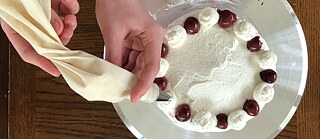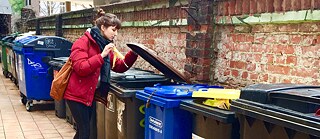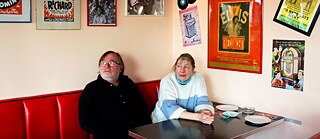Much more than just a pick-me-up
Culture of Coffee
Are there cultural differences in the consumption of coffee? We explore the meaning of coffee across cultures, from Baltimore to Berlin. Plus, a glimpse into the German tradition of ‘Kaffee und Kuchen,’ or afternoon coffee and cake.
Listen to this episode: Apple Music | Spotify | Download
This episode is by Nina Bohlmann. Nina grew up with German parents in Reno, Nevada, and Baltimore, Maryland. She learned how to produce podcasts at WYPR, Baltimore’s public radio station. Since her return to Berlin, she has been capturing exciting stories to air on the radio. In this podcast, Nina talks to coffee experts from VENT Coffee Roasters in Baltimore and Bejte Ethiopia in Berlin. The song “One More Round” by David Szesztay is licensed through Needle Drop Co., and “4” by Matt LeGroulx is under a CC BY-NC-SA 3.0 license. The sound effects in this episode are in the public domain. In addition to this episode, Nina produced the episode “Sorting Out Recycling.”
Transcript
Nina Bohlmann: It’s the 11th century in Ethiopia, and Kaldi, a goat herder, is walking through the province Kaffa with his herd. One day, he notices that his goats are acting sort of strange — jumping around, all excited. He sees that they are eating these little red berries — and, intrigued, he tries some for himself. He, too, suddenly feels way more energetic. Excited about this magical fruit, he brings it to a monk. But the monk disregards the berries and throws them into the fire. But as the berries burn, this incredible aroma draws both of them back in. One way or another, they have the idea of grinding the beans and mixing them with hot water ... and coffee is born [POURING COFFEE]. At least, that’s the most common version of the story. How, when, and where coffee was born is actually a contested issue — many countries claim to have discovered coffee. But what’s undeniable is that coffee has since spread across the globe and has gotten a lot of us hooked — no matter how we like it best.
Male voice: Plain, black coffee.
Female voice: Just a tiny bit of demerara sugar.
Male voice: Costa Rican, fair trade.
Female voice: A lot of sugar and cream.
Nina Bohlmann: Over the course of centuries, coffee has taken on an important role both in many caffeine addicts’ day-to-day, but also in the cultures of many countries and communities. Today, we are going to take a look at the coffee culture in the United States and in Germany — and finally take it back to where it all began: Ethiopia.
To start this, I wanted to find out what even makes up a good cup of coffee. So I talked with Sarah Walker, the owner of VENT Coffee Roasters in Baltimore, Maryland. Our conversation echoes through her newly opened coffee shop, a converted warehouse space with a hipster garage-type feeling — concrete floors, big floor-to-ceiling windows, and wooden tables.
Sarah Walker: The roast, to start — my personal preference is nothing too dark. I really like a lot of just medium coffees, and just figuring out your profile. Because every seed — so we call it beans, I don’t know why, but it’s actually a pit to a cherry, which grows on a tree. Every county and every region in that country — even from one side of the mountain to the other side of the mountain — can have different flavor characteristics because on this side of the mountain, it might get more sun than this side, and the other plants and trees that are around it. Coffee trees can absorb different things, you know. That being said, I think that in the roasting process, when you go too long in a roast, you kill those individual characteristics. Because then you taste more just about the roast than you do those characteristics. A natural processed Ethiopian can taste like blueberries. We have a Kenya right now that tastes like heirloom tomatoes, and that sounds so weird to people, but if I had to put a favorite country that coffee comes from, Kenya would be it. And then it’s just how you brew it. Not every coffee is meant for every brew method. There is a little bit of science that goes into it, as far as ratios.
Nina Bohlmann: But apart from offering high-quality coffee in the area, Sarah is trying to use coffee to create connections between people. Because in the end ...
Sarah Walker: Coffee is just coffee. It’s funny because there are both sides that kind of just — I think they do come together. Like, coffee is a beverage to be enjoyed with community, with other people, just a part of your day, a part of your life. So, it also doesn’t need to be that for everyone, you know? Coffee is just, it’s coffee — it’s a beverage that people can come around. And I think that can’t be forgotten, even if you can geek out on all the different equipment or brew methods or whatever. Like, it’s still this foundation for a community and conversation.
Nina Bohlmann: But coffee as something to come around is not necessarily always the way that many people here consume coffee. This is David, a student in Berlin. He did an exchange at the University of Minnesota last year, and one thing in particular stood out to him about the coffee shops there.
David: So, you basically always get a to-go cup, so you can just leave if you want. Whereas here, you get, like, a porcelain, china cup. So, like, if you suddenly want to leave, you kinda can’t — because you have to finish your cappuccino or whatever it is first. And I guess, a part of that is about sustainability, which is great, but another part is that it just forces you to maybe be more mindful, a little bit slower. Which I guess is a good thing, because I don’t think coffee should only be about the stimulation aspect. I mean, like, sure — I enjoy that as well, but cafés can offer a good chance to just like step back a little bit as well.
Nina Bohlmann: So, while this is not necessarily true for all coffee shops, it is something that I have noticed as well — in general, and with the exception of Starbucks — in Germany, your coffee will be served in a mug unless you specifically ask for it to go. In the U.S., more often than not, your drink will be served in a paper or plastic cup unless you specifically ask for a mug. But apart from how it’s consumed, David also noticed a difference in why it’s consumed.
David: I do think that in the U.S., the ‘performance-enhancing’ side is more important or more emphasized, especially in colleges. Like, my second time abroad in the U.S. for a year, I was at the University of Minnesota. And I definitely noticed that there a lot of people be drinking coffee, not because they liked it, or even because they were like, “Yeah, I just need my morning coffee.” But like, explicitly to like, “I need to pay better attention in class,” or like, “I need to study for my final.” Whereas in Germany, for most people who do drink coffee, it seems more of an enjoyment thing. There definitely is a certain extent of the whole, “I need to be more alert.” But I do think it’s way more pronounced in the U.S.
Nina Bohlmann: To learn about ‘Kaffeekultur’ — coffee culture in Germany — I spoke with a local expert here in Berlin.
Jochen Hintze: My name is Jochen Hintze, I am the owner and founder of JOcaffè Rösterei und Maschinen, which is a shop roastery. We have a coffee roaster in our shop, and we serve coffee as well. And we sell coffee in beans and grounds to private customers mainly, and also to other cafés and so on.
Nina Bohlmann: Although he is a mechanical engineer by trade, Jochen has always had a connection to coffee.
Jochen Hintze: I remember very well my grandma sitting in her room, in our house, in the afternoon, drinking a cup of coffee. And this coffee smelled or had this distinctive or certain smell — a certain aroma. And I was remembering this aroma when I started to roast Kenyan coffee eight or nine years ago. So, imagine nine years ago, I was able to remember a moment in my life, which was 30 or 40 years earlier. So, I had the fascination of coffee when I was smelling the coffee in grandma’s room. I started to drink coffee with an age of 13 or 14, I suppose.
Owning a coffee shop for me is a big satisfaction. As with our work, we care about people, so we care for them — we allow them to have a moment of relax. We also give them the chance to meet each other. That’s actually what that we are realizing with our customers who join us every day. We have so many people working or living in the same neighborhood, which do not know each other before they met here. And they started talking, and then later on they exchanged their phone numbers, and later on they made an appointment to come here to drink coffee. So this is something about bringing people together, and this is very satisfying for me to see this.
Nina Bohlmann: Jochen, just like Sarah, focuses on high-quality roasts. Something that has become more sought after here in Germany in the past few decades. But this isn’t the typical coffee culture that I know and love. Instead, what is one of the nicest things about a weekend afternoon in Germany, in my opinion, is ‘Kaffee und Kuchen’ — or coffee and cake.
Jochen Hintze: It’s quite interesting, we call it also ‘Konditoren gehen.’ So, a ‘Konditorei’ is a cake shop, which is specialized in producing cakes. And to visit a Konditorei is something you do on the weekend. On Saturdays or Sundays in the afternoon, you go to a Konditorei and eat a piece of cake and have a cup of coffee. This is German coffee culture at its best, at former times at least. Nowadays, let’s say in the last 15 years, coffee culture has changed quite a bit.
Nina Bohlmann: Jochen really fell in love with coffee in Italy, but was disappointed to find that in the mid-’80s, espresso culture was hard to come by in Germany, even though only the Alps separate the two countries.
Jochen Hintze: We had to wait until Starbucks came from the U.S. to make their own shops in Germany, to introduce a certain espresso culture. I call it always a ‘Starbucksization.’ And ‘Starbucksization’ helped small coffee shops like mine a lot, because they created some different coffee culture. A culture of drinking coffee outside instead of your home, of drinking espresso and mixed drinks with milk, like cappuccino, latte, and so on, instead of drip coffee like German grandmas were used to do.
Nina Bohlmann: For a long time, coffee culture in Germany was not centered around the quality of the coffee, but rather around the act of drinking it together. Although it’s not as typical today as it used to be, ‘Kaffee und Kuchen’ is still a landmark of German culture. Families and friends slicing some time out of their afternoons to share conversation over homemade cakes and a cup of coffee.
So, if coffee has adopted such a big role in societies on both sides of the pond, I asked myself what it must be like in Ethiopia, where coffee has presumably been consumed the longest. To find out, I went to Bejte Ethiopia, a bustling little restaurant in my neighborhood in Berlin, and spoke with Wubit.
Wubit Talahun: My name is Wubit Talahun.
Nina Bohlmann: Every night, a coffee ceremony is performed here, among diverse Ethiopia paraphernalia, for a widespread customer base, ranging from the Ethiopians at the counter to the German ladies in the corner discussing their grandchildren. At 8 p.m., a woman in a traditional Ethiopian dress starts a coal fire in a little pot on the floor. She places frankincense sap in the hot embers. Wubit explained the steps involved in the coffee ceremony as the beans are roasted in a little metal pan, which you can hear in the background amongst the lively chatter of the guests.
Wubit Talahun: So now she has started the coffee ceremony. As the ceremony we have the fragrance — in German, it’s called ‘Weihrauch.’
Nina Bohlmann: Or in English, frankincense.
Wubit Talahun: And then she is roasting the coffee bean — and they are green, but she is going to roast it. And then, when it’s a little bit brown or dark brown, so, it’s going to be finished. And then she takes them away and she goes to the people around and makes them to smell, because that is a part of the ceremony or the culture.
Nina Bohlmann: By now, the room has filled with smoke and the smell of coffee. Wubit also showed me the traditional wooden mortar and pestle used to grind coffee.
Wubit Talahun: And that is how we make it to powder. We put the coffee here and we make it like that [POUNDING]. And it’s really good, when you take the grinding machine, it gets really powdered, very powder. But with this, it’s not really fully grinded. So, when you cook the coffee, it has a taste.
Nina Bohlmann: The coarsely ground coffee is then brewed in a jebena, a black clay coffeepot with a round bottom and a narrow spout.
Wubit Talahun: And the way that she cooks it is a little bit different, because we use coal. And there it will be cooked very slowly, and then when it is boiled, she takes out. She takes down, and then she keeps it for a minute — like five minutes — and then it will start to ... I don’t know how to call it. The coffee will go down, the coffee bean or the powder will go down and then the coffee, the right one, it will come up.
Nina Bohlmann: After 45 minutes, the first round of coffee was poured into little cups.
Wubit Talahun: The first round is called ‘Abol.’ And then it comes the second round, and the second round is that on the bottle, we put a little bit more water, so the second round is called ‘Tona,’ they will take this little bit stronger coffee. And then the last one is ‘Bereka,’ and then this is not really strong. It’s like the last one to say goodbye and so on.
Nina Bohlmann: And it’s really good. Strong, but not bitter at all, which is not what I am expecting. But apart from the coffee being such a big part of the day-to-day of many Ethiopian households, the quality of the coffee speaks for itself.
Wubit Talahun: I recommend to drink my coffee, Ethiopian coffee, I don’t know why. I try sometimes to go buy Ethiopian coffee, I try to choose, because nowadays they have many cafeterias with Ethiopian coffee, but I take also normal, yeah. But when it’s Ethiopian coffee, I drink black coffee outside, but if it is not Ethiopian, I do not drink coffee ... I take latte or cappuccino [IN GERMAN] und so.
Nina Bohlmann: But you can have beans from the most exotic places in the world, with aromas like banana and pineapple — or even lime. You can prepare it with elaborate ceremonies, with an espresso machine, or with your Ikea French press. You can add sugar, milk, or leave it black. Because at the end of the day, the best cup of coffee is the coffee shared with good company. From Berlin, this is Nina Bohlmann for THE BIG POND.







